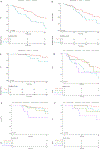The Mutational Landscape of Metastatic Castration-sensitive Prostate Cancer: The Spectrum Theory Revisited
- PMID: 33419682
- PMCID: PMC10262980
- DOI: 10.1016/j.eururo.2020.12.040
The Mutational Landscape of Metastatic Castration-sensitive Prostate Cancer: The Spectrum Theory Revisited
Abstract
Background: Emerging data suggest that metastasis is a spectrum of disease burden rather than a binary state, and local therapies, such as radiation, might improve outcomes in oligometastasis. However, current definitions of oligometastasis are solely numerical.
Objective: To characterize the somatic mutational landscape across the disease spectrum of metastatic castration-sensitive prostate cancer (mCSPC) to elucidate a biological definition of oligometastatic CSPC.
Design, setting, and participants: This was a retrospective study of men with mCSPC who underwent clinical-grade sequencing of their tumors (269 primary tumor, 25 metastatic sites). Patients were classified as having biochemically recurrent (ie, micrometastatic), metachronous oligometastatic (≤5 lesions), metachronous polymetastatic (>5 lesions), or de novo metastatic (metastasis at diagnosis) disease.
Outcome measurements and statistical analysis: We measured the frequency of driver mutations across metastatic classifications and the genomic associations with radiographic progression-free survival (rPFS) and time to castrate-resistant prostate cancer (CRPC).
Results and limitations: The frequency of driver mutations in TP53 (p = 0.01), WNT (p = 0.08), and cell cycle (p = 0.04) genes increased across the mCSPC spectrum. TP53 mutation was associated with shorter rPFS (26.7 vs 48.6 mo; p = 0.002), and time to CRPC (95.6 vs 155.8 mo; p = 0.02) in men with oligometastasis, and identified men with polymetastasis with better rPFS (TP53 wild-type, 42.7 mo; TP53 mutated, 18.5 mo; p = 0.01). Mutations in TP53 (incidence rate ratio [IRR] 1.45; p = 0.004) and DNA double-strand break repair (IRR 1.61; p < 0.001) were associated with a higher number of metastases. Mutations in TP53 were also independently associated with shorter rPFS (hazard ratio [HR] 1.59; p = 0.03) and the development of CRPC (HR 1.71; p = 0.01) on multivariable analysis. This study was limited by its retrospective nature, sample size, and the use of commercially available sequencing platforms, resulting in a limited predefined set of genes examined.
Conclusions: Somatic mutational profiles reveal a spectrum of metastatic biology that helps in redefining oligometastasis beyond a simple binary state of lesion enumeration.
Patient summary: Oligometastatic prostate cancer is typically defined as less than three to five metastatic lesions and evidence suggests that using radiation or surgery to treat these sites improves clinical outcomes. As of now, treatment decisions for oligometastasis are solely defined according to the number of lesions. However, this study suggests that tumor mutational profiles can provide a biological definition of oligometastasis and complement currently used numerical definitions.
Keywords: Next Generation Sequencing; Oligometastatic prostate cancer.
Copyright © 2021 The Authors. Published by Elsevier B.V. All rights reserved.
Figures



References
Publication types
MeSH terms
Grants and funding
LinkOut - more resources
Full Text Sources
Other Literature Sources
Research Materials
Miscellaneous

